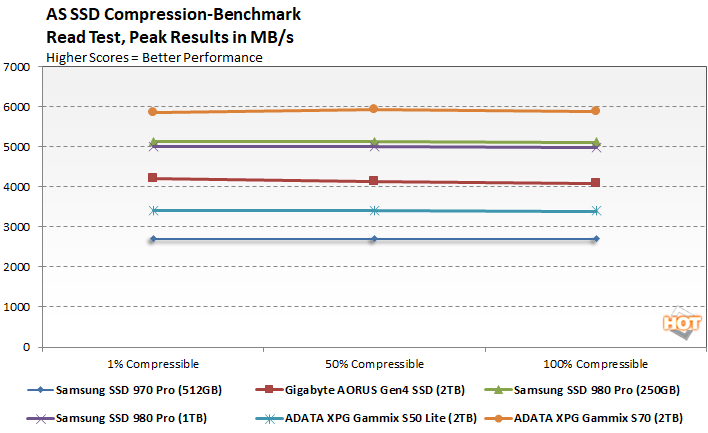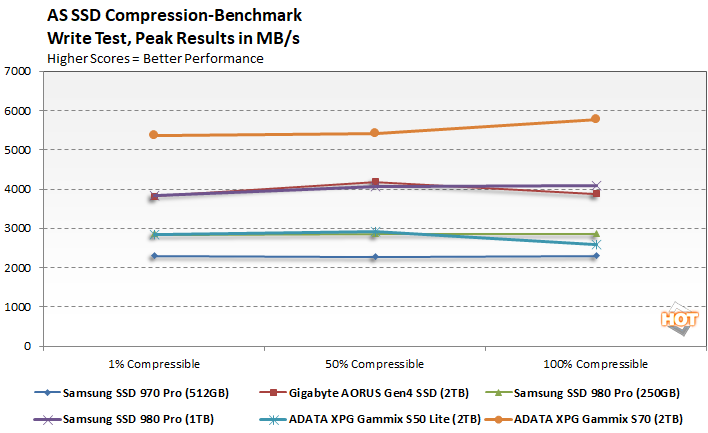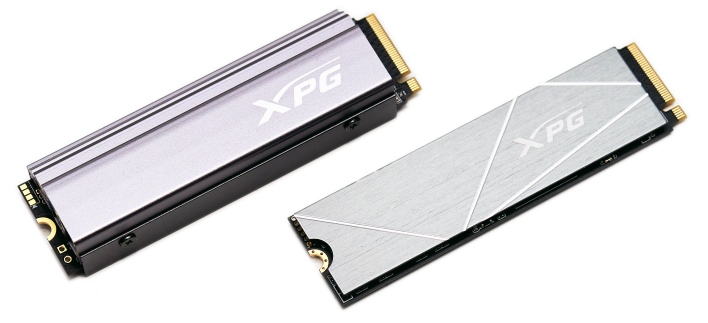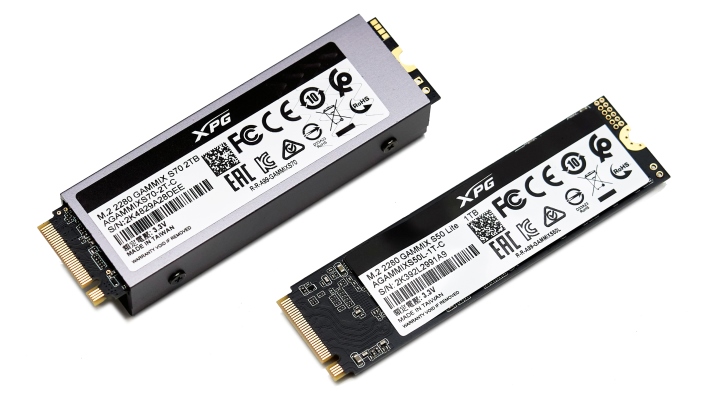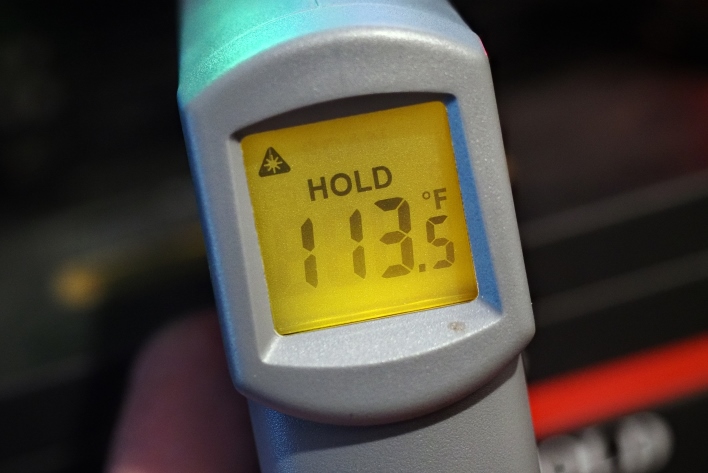ADATA XPG GAMMIX S70 And S50 Lite Review: PCIe 4 Speed Or Value
ADATA XPG Gammix S70 And S50 Lite: NVMe PCIe 4 Storage For All
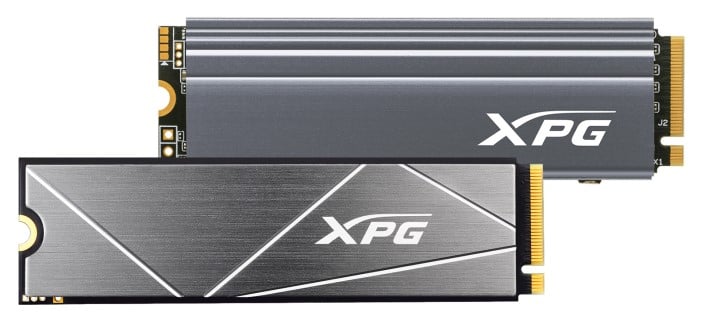
The ADATA XPG GAMMIX S70 and XPG GAMMIX S50 Lite are two very different drives, however. Though they both offer strong performance at their respective price points and, as you’ll see in just a moment, the two drives target different segments of the market. XPG's GAMMIX S70 specifications foreshadow one of the fastest SSDs currently available, while the GAMMIX S50 Lite is a bit tamer and more budget-friendly. Take a look for yourselves...
|
| XPG GAMMIX S70 | XPG GAMMIX S50 Lite | |
| Capacity | 1TB / 2TB | 1TB / 2TB |
| Form Factor | M.2 2280 | M.2 2280 |
| NAND Flash | 3D NAND | 3D NAND |
| Dimensions (L x W x H) | 80 x 25 x 15mm | 80 x 22 x 4.3mm |
| Weight | 34g | 10g /3.5oz |
| Interface | PCIe Gen4x4 | PCIe Gen4x4 |
| Sequential Read (Max) | Up to 7400MB/s2 | Up to 3900MB/s2 |
| Sequential Write (Max) | Up to 6400MB/s2 | Up to 3200MB/s2 |
| Operating temperature | 0°C - 70°C | 0°C - 70°C |
| Storage temperature | -40°C - 85°C | -40°C - 85°C |
| Shock resistance | 1500G/0.5ms | 1500G/0.5ms |
| MTBF | 2,000,000 hours | 2,000,000 hours |
| Warranty | 5-year limited warranty | 5-year limited warranty |
Like the vast majority of M.2 drives currently on the market, ADATA's XPG GAMMIX S70 and XPG GAMMIX S50 Lite use the common M.2 2280 (80mm) "gumstick" form factor. ADATA utilizes dark-colored PCBs with the drives, and populates both sides of the boards with an array of components, but everything is covered by integrated heat-spreaders or heatsinks and decals.
At the heart of the ADATA XPG GAMMIX S70 is a new 8-channel InnoGrit IG5236 controller. In fact, this is the first SSD we have seen featuring the InnoGrit IG5236. That controller is paired to Micron's latest 96-Layer TLC NAND Flash memory and a few pieces of DDR4 DRAM cache memory. The drive features a PCIe Gen 4 x4 interface and support for the NVMe 1.4 specification.
The ADATA XPG GAMMIX S50 Lite features the same 96-Layer Micron NAND as the GAMMIX S70, and it too has a PCIe Gen 4 x4 interface, but this drive is built around the more affordable Silicon Motion SM2267EN controller.
Ultimate performance levels of the ADATA XPG GAMMIX S70 and XPG GAMMIX S50 Lite vary depending on the capacity. We are looking at a 1TB GAMMIX S50 Lite and 2TB GAMMIX S70 here. The XPG GAMMIX S70 is rated for impressive 7.4GB/s sequential reads, and 6.4GB/s writes. The GAMMIX S50 Lite’s sequential reads and writes come it at 3.9GB/s and 3.2GB/s, respectively. Both drives have the same MTBF and carry the same 5-year warranty. ADATA hasn’t listed endurance ratings for the GAMMIX S70, unfortunately, but the GAMMIX S50 Lite is rated for 1480TBW.
Due to its leading-edge controller and high-performance levels, the XPG GAMMIX S70 features a relatively large heatsink, that wraps around the entire drive. The GAMMIX S50 Lite features a much more common, flat, thin, metal heat spreader. And that heatsink on the GAMMIX S70 isn’t just for show. During testing, we saw drive temps reach about 60°C under long sustained loads, when benchmarking the drive inside our test-bed’s mid-tower chassis. Surface temps on the heatsink get pretty toasty too – reaching over 113°F / 45°C, so it's paramount that this drive is installed in systems with adequate cooling to prevent throttling.
We should also mention that the XPG GAMMIX S70’s heatsink may preclude it from fitting in some systems. If your motherboard has especially thick thermal pads or protruding M.2 2260 / 2240 mounts, they may prevent the S70 from seating properly in the slot.
Included with the ADATA XPG GAMMIX S70 and XPG GAMMIX S50 Lite is support for the company’s SSD Toolbox utility, for monitoring, maintaining, and updating the drive. The interface for the tool is somewhat colorful and dated looking, but the functionality and feature set is adequate. ADATA also includes a copy of Acronis True Image with the drives. Both utilities are available to download from ADATA’s site.
While we're on the subject of downloads, both of these drives have updated firmwares available that improve performance significantly. Should you purchase either drive, before migrating or loading the drives up with data, we strongly recommend grabbing the latest firmwares and updating the drives to ensure they’re running tip-top.
ADATA XPG Gammix S70 And S50 Lite Benchmarks
Under each test condition, the SSDs tested here were installed as secondary volumes in our testbed, with a separate drive used for the OS and benchmark installations. Our testbed's motherboard was updated with the latest BIOS available at the time of publication. The SSDs were secure erased prior to testing (when applicable), and left blank without partitions for some tests, while others required them to be partitioned and formatted, as is the case with the ATTO, PCMark, and CrystalDiskMark tests. Windows firewall, automatic updates, and screen savers were all disabled before testing and Windows 10 Quiet Hours / Focus Assist was enabled.
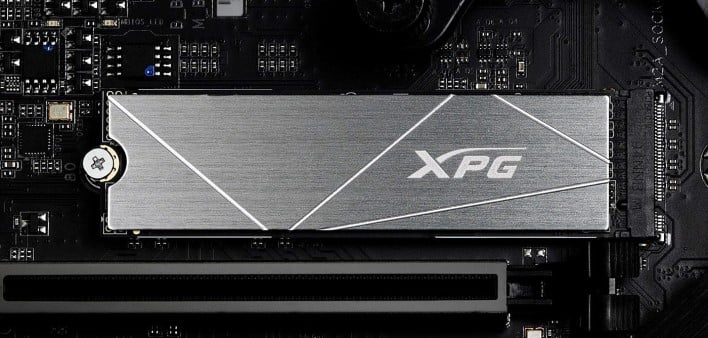
|
| Processor - Motherboard - Video Card - Memory - Audio - Storage - |
AMD Threadripper 3990X MSI TRX40 Creator (TRX40 Chipset) GeForce RTX 2080 Ti 32GB G.SKILL DDR4-3200 Integrated on board Corsair MP600 (OS Drive) Samsung SSD 980 Pro (1TB) Gigabyte Aorus NVMe PCIe 4 (2TB) Samsung SSD 970 Pro (512GB) ADATA XPG GAMMIX S70 (2TB) ADATA XPG GAMMIX S50 Lite (1TB) |
OS - Chipset Drivers - DirectX - Benchmarks - |
Windows 10 Pro x64 (2004) AMD v2.07.14.327 DirectX 12 IOMeter HD Tune v5.75 ATTO v4.01.0f AS SSD CrystalDiskMark v7 x64 PCMark 10 Quick Storage Bench SiSoftware SANDRA |
|
In the following tables, we're showing two sets of access patterns; a custom Workstation pattern, with an 8K transfer size, consisting of 80% reads (20% writes) and 80% random (20% sequential) access and a 4K access pattern with a 4K transfer size, comprised of 67% reads (33% writes) and 100% random access. Queue depths from 1 to 32 were tested...
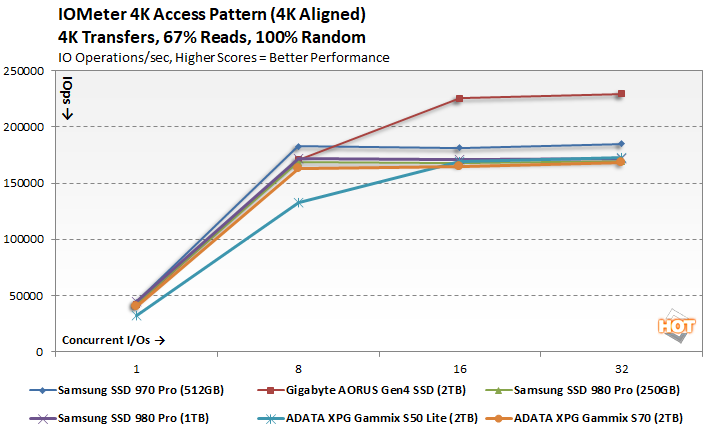
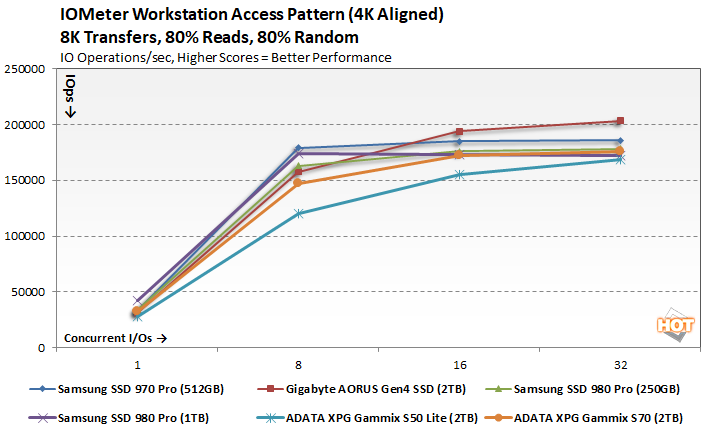
The ADATA XPG GAMMIX S50 Lite slightly trails the other drives we tested across the various queue depths, while the GAMMIX S70 is right in the mix with drives like the Samsung SSD 980 Pro and Phison-based Aorus Gen 4 SSD, at least with the workstation access pattern. With the fully random 4K access pattern, the Aorus Gen 4 SSD pulls ahead of the other drives at the higher queue depths.


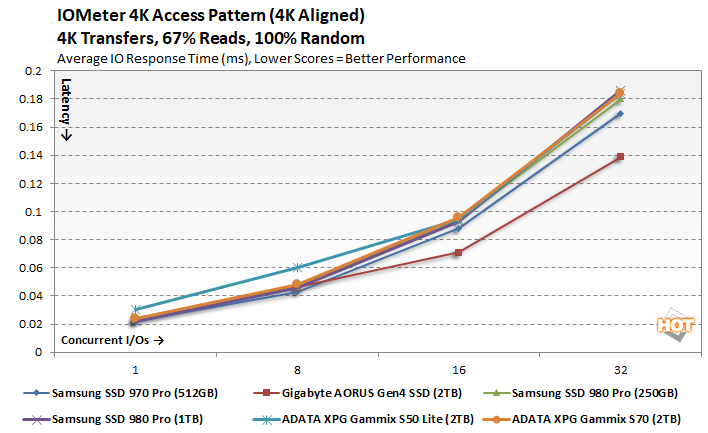
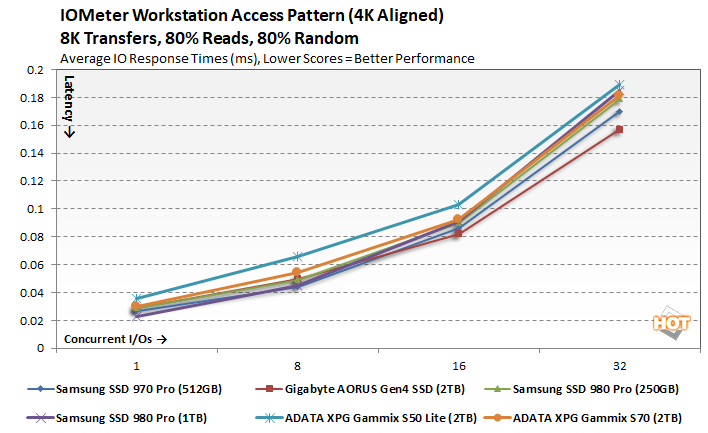
|
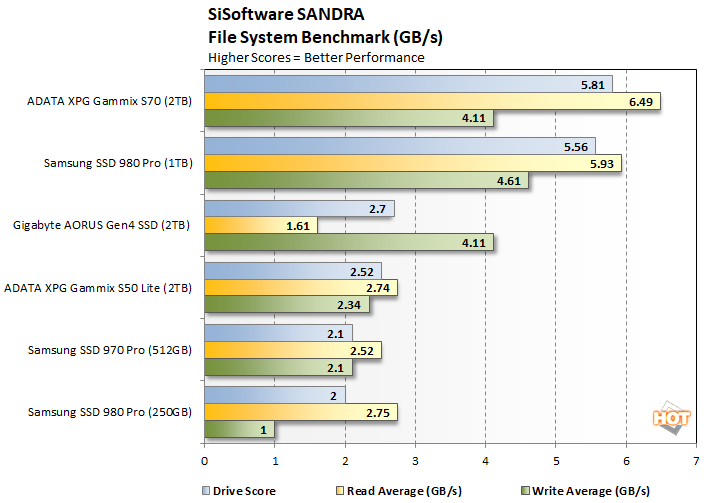
|
ATTO is another "quick and dirty" type of disk benchmark that measures transfer speeds across a specific volume length. It measures raw transfer rates for both reads and writes and graphs them out in an easily interpreted chart. We chose .5KB through 64MB transfer sizes and a queue depth of 6 over a total max volume length of 256MB. ATTO's workloads are sequential in nature and measure raw bandwidth, rather than I/O response time, access latency, etc.
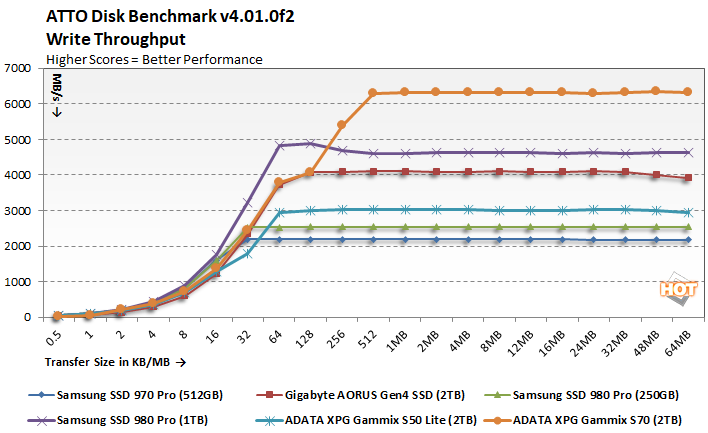
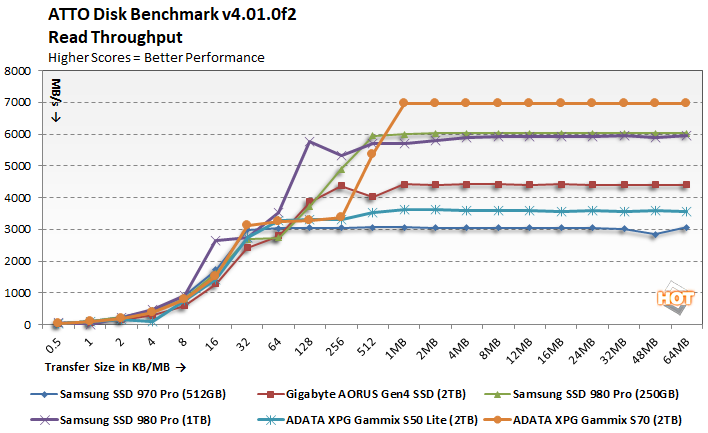
In ATTO's read and write bandwidth tests, the ADATA XPG GAMMIX S70 is a beast. The drive was right in the mix with the smallest transfer sizes, but it pulls ahead by a wide margin with the larger, sequential writes. The S50 Lite also performed relatively well, landing right in between the Samsung SSD 970 Pro and Aorus Gen4 SSD.
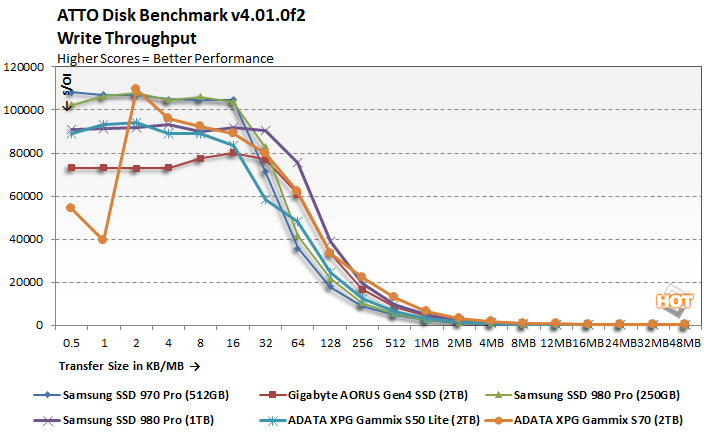
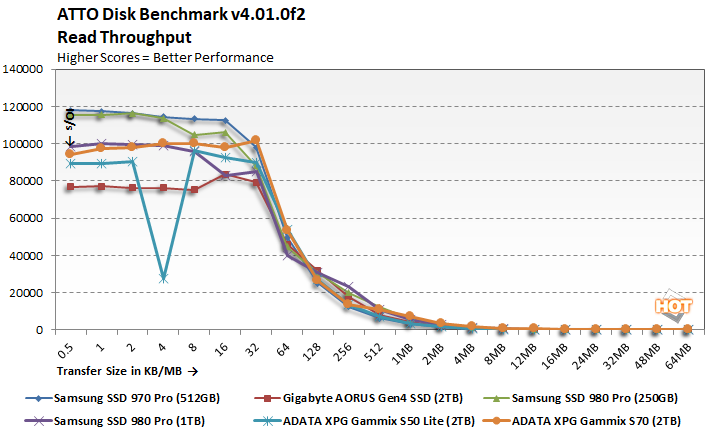
Both the ADATA XPG GAMMING S70 and S50 Lite consistently exhibited some wild swings in terms of their peak IOs, but disregarding the couple of anomalies, the drives land right about in the middle of the pack.
|
Next up we ran the Compression Benchmark built-into AS SSD, an SSD specific benchmark being developed by Alex Intelligent Software. This test is interesting because it uses a mix of compressible and non-compressible data and outputs both Read and Write throughput of the drive. We only graphed a small fraction of the data (1% compressible, 50% compressible, and 100% compressible), but the trend is representative of the benchmark’s complete results.
